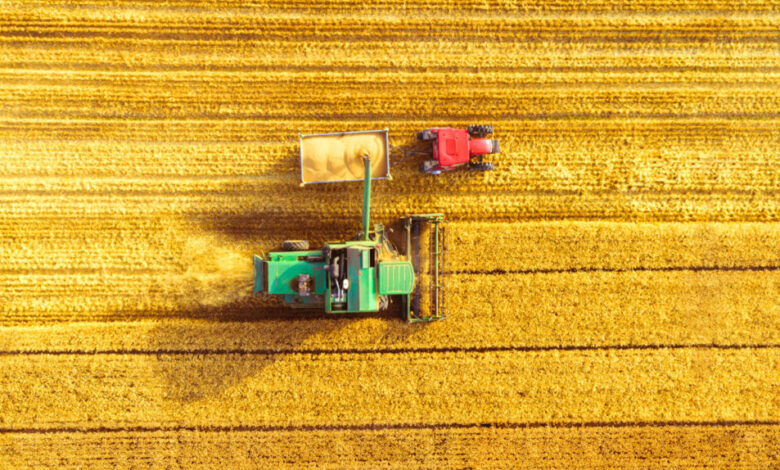Reviewing the 2023 commodity market performance

KANSAS CITY — Grain and oilseed futures prices tumbled in calendar 2023 mainly on ample supplies and limited export opportunities, while soft commodity (sugar, cocoa, coffee) futures rose amid tight supplies. Prices of other ingredients, including egg and dairy products, mostly were lower.
Record-high US corn production (up 11% from 2022) and increased export competition from Brazil, which also had record-high corn outturn, sent the nearby corn future down 31% in the year ended Dec. 29, the largest annual decline since 2013 and the largest percentage drop of the major commodities in 2023.
Prices for wheat and flour also tumbled except for durum, which ended the year down slightly, and semolina, which was up slightly, as lower Upper Midwest millfeed prices more than offset weaker durum values. The Sosland Publishing Co. pasta ingredient index was about flat for the year.
But other ingredient indexes, including cake donut, devil’s food cake, saltine cracker and short bread cookie, dropped sharply. The smallest decline of 17% was posted in the white pan bread index.
The nearby Chicago wheat future (soft red winter used in cookies, crackers and mixes) dropped 21% for the year on sharply higher 2023 production. Prices recovered modestly after China bought more than 1.6 million tonnes of US soft red winter wheat late in the year. But export demand for other wheat classes, especially hard red winter, were limited by lower-priced supplies mainly out of the Black Sea region with Russia the world’s largest wheat exporter. The nearby KC wheat future (hard red winter, the main bread-making flour) fell 28%, and the Minneapolis future (hard red spring used in artisan bread and other products) fell 23%. The price of flour associated with those specific wheat varieties (winter/spring blends, spring standard patent and cracker flour) all were down about 20%.
The change in wheat futures is only part of the equation determining flour prices. The basis levels on cash wheat in both Kansas City and Minneapolis also were down sharply, with hard red winter wheat (KC) down 36% and hard red spring (Minneapolis) down 27%. A third key factor that tended to offset lower futures prices was sharply lower millfeed values. Kansas City spot millfeed plunged more than 40% for the year, with prices down in most other regions as well, allowing millers to boost flour prices.
In the soy complex, South America production kept pressure on US soybean and soy oil prices even with US soybean production down 3.3% from 2022. The nearby Chicago soybean future was down 15% for the year as Brazil, the world’s largest soybean producer and exporter, posted record-high production in 2023.
Cash soybean oil prices (basis Decatur, Ill.), dropped even more, falling 25% year-over-year despite growing demand from the renewable fuel sector, due in part to increased global supplies of other edible oils, including canola oil from Canada.
In contrast to grains and oilseeds, soft commodity prices soared in 2023 mainly on concerns about tight supplies.
Cocoa bean futures set all-time highs in London and 46-year highs in New York as forecasts of sharply lower cocoa bean production in West Africa (top producer Ivory Coast 2023-24 production was forecast down 25%) was expected to result in a third consecutive year of global cocoa deficit.
Sugar futures, New York world and domestic raws, ended the year with modest gains of 2.7% and 7%, respectively, as a late-year selloff by commodity funds prompted by record-high sugar production in Brazil sent prices sharply lower from earlier decade-plus highs prompted by El Niño-reduced sugar production in India and Asia. Prices for bulk refined cane sugar ended the year lower but remained historically high above 60¢ a lb.
The egg and egg product market began and ended the year influenced by highly pathogenic avian influenza (HPAI). The poultry industry was devastated by a year-long outbreak of HPAI in 2022 that sent graded shell egg prices to record highs in December. Egg prices corrected sharply as the year progressed with no HPAI outbreaks in commercial laying flocks until November 2023, with nearly 13 million hens euthanized since then. But the 2023 losses were considerably fewer than in 2022. Egg prices moved higher late in 2023 but still were down nearly 60% from the end of 2022. Egg product values also were down sharply for the year with dried whole egg values dropping 55%. HPAI in 2023 hit at a time of seasonally lower egg product demand, and egg product prices barely moved.
Dry dairy product prices mostly were down from 2022 as well, but most values inched higher in the final months of 2023 as monthly milk production tracked below year-ago levels in the last half of the year. The price of low/medium-heat nonfat dry milk was down 13% for the year. Butter prices, however, were up 12% for the year after setting a record high in early October amid tight supplies during the fall baking season and heading into the strong demand period of the yearend holidays.





